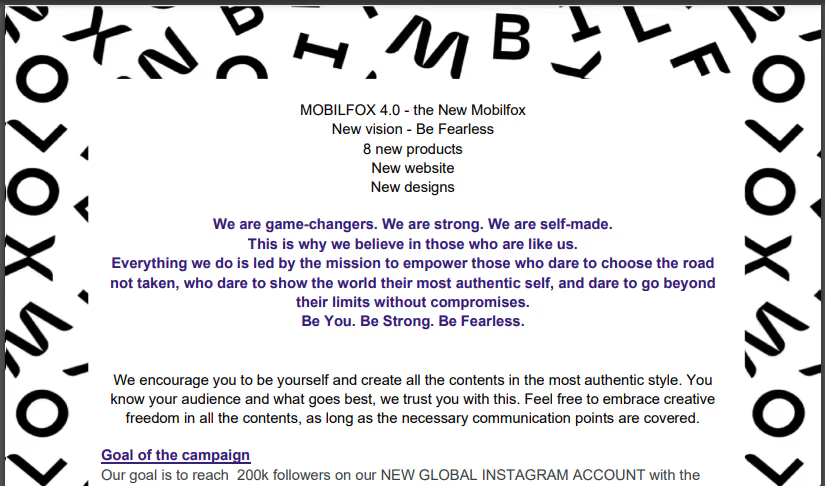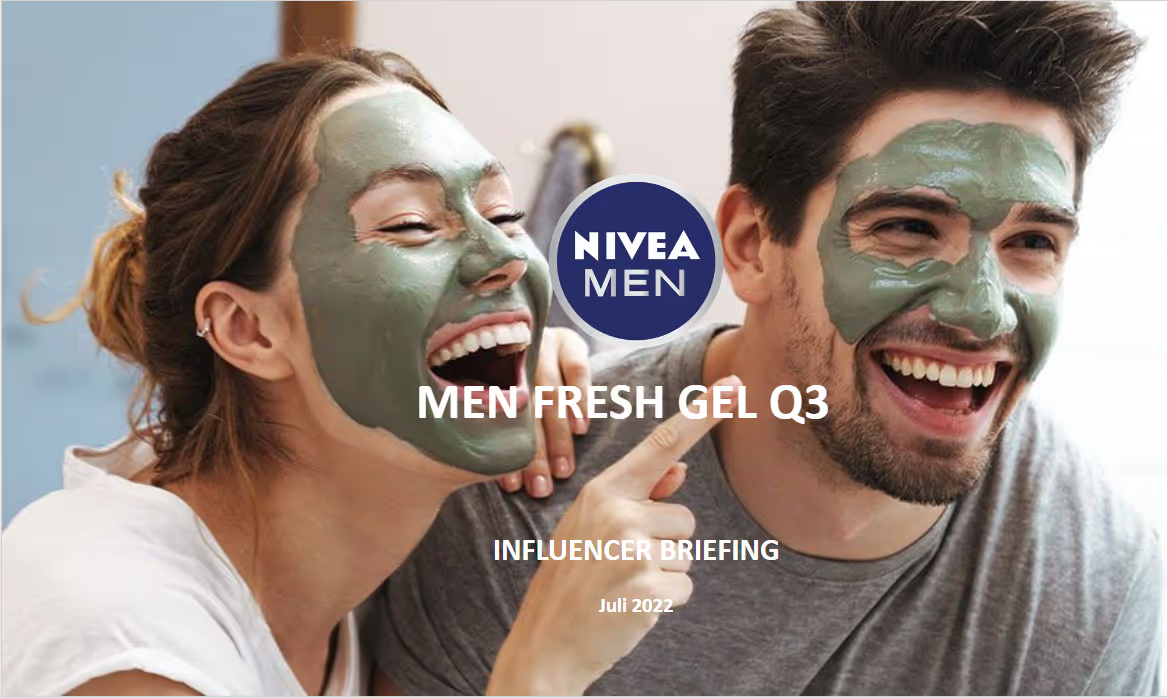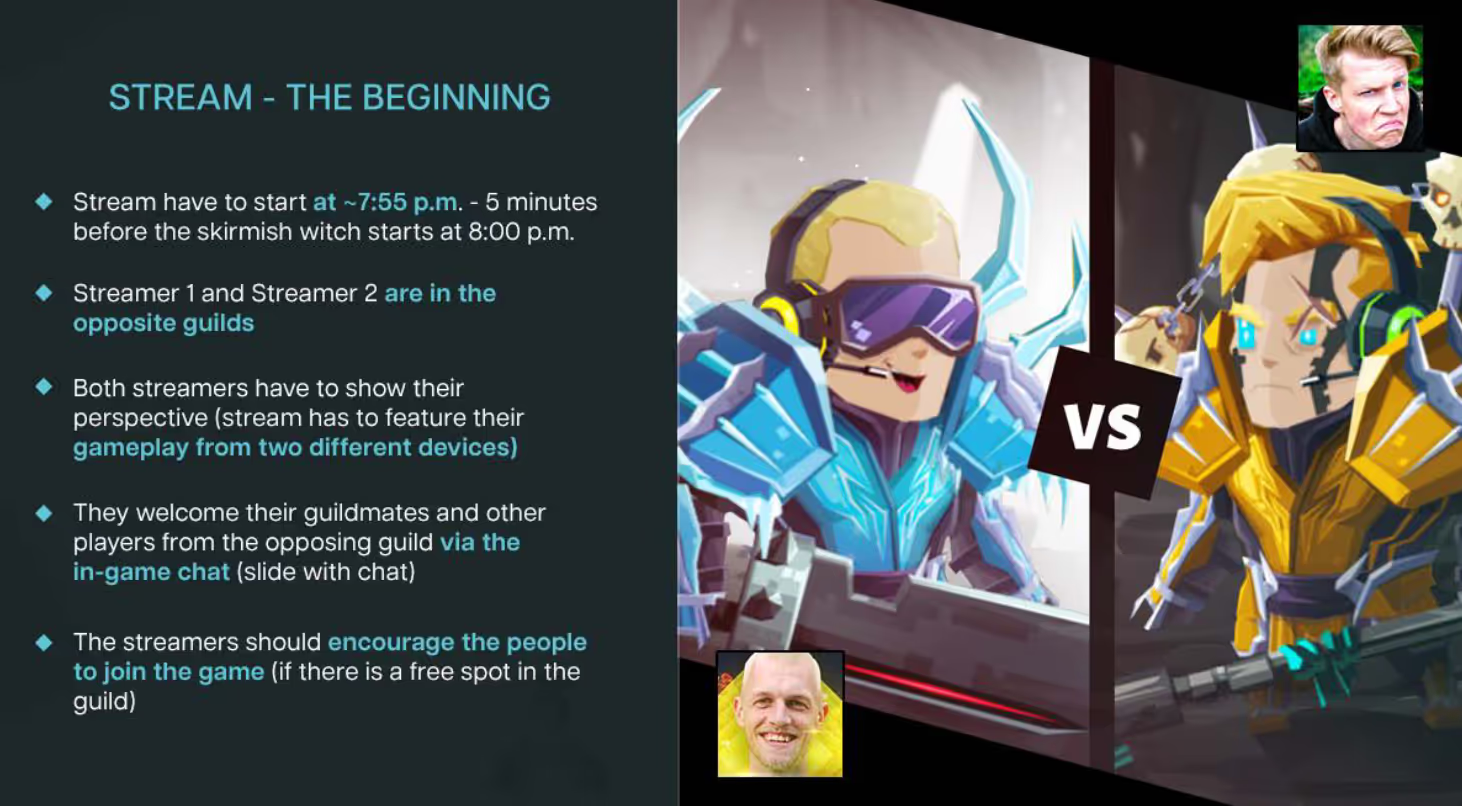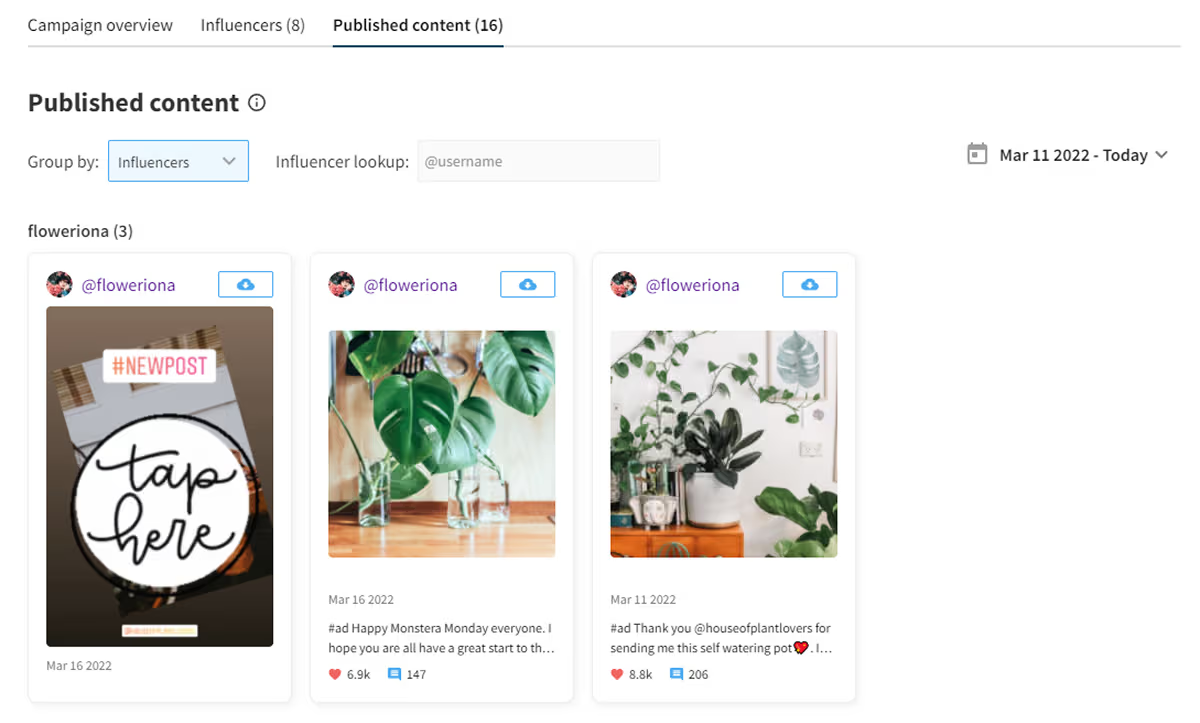Imagine someone hands you a blank sheet of paper and asks you to draw something. What would you draw?
Chances are, you’ll draw a blank.
Now imagine that this person asks you to draw a house. When you have some guidelines, creation becomes so much easier. It’s harder to create something from scratch vs. something from a prompt.
Influencer briefing works the same way.
The best influencer briefs balance out creative freedom with brand guidelines and business goals. Giving too many requirements and restrictions to creators will make your collaboration appear forced and inauthentic.
The trick is to provide the maximum possible creative freedom, while also:
- Setting expectations of what your creator can expect while working with you
- Empowering your influencer by highlighting your goals, brand messaging, and overall story
- Aligning everyone around the primary goal/KPI for the campaign
Preparing a brief template that checks those boxes is going to speed up your workflow drastically – not to mention improving the creative output at the same time.
TL;DR? Here’s our template. Make a copy and customize it for your brand 😄.
What is an influencer brief?
An influencer brief is a quick document that gives your creator everything they need to know about working with you. A good brief will give the influencer:
- Direction and guidelines for content
- The goals you want to achieve with your campaign
- Brand messaging and product information
- Timelines, communication outlines, and deliverable expectations
A great influencer brief makes working with you much easier for the creator. It helps show them what’s important to you, and why their audience would be interested in the products you’re showcasing.
Providing clear influencer briefs:
- Improves the quality of the content output
- Saves time on back-and-forth communication with each creator
- Shows that you're professional and organized
Sarah Saffari, Founder of InfluencerNexus, compares influencer briefing to getting into a relationship.
Not giving a proper brief is like agreeing to a committed relationship with someone, without having any prior conversations about what a relationship would look like.

It just makes more sense to lay out expectations from the beginning.
7 Things to include for an effective & concise influencer brief
1. Company & product overview
Don’t send your creator a novel. You’ll want to keep this section short and sweet: only include the information that’s totally relevant to your products and brand.
Write a short introduction to your company and product. Focus on the why:
- Why do you do what you do?
- Why does a customer want your product? (How do you solve their problem?)
- Why would a customer choose your product over another?
Include your brand messaging and what story you’re trying to tell. It doesn’t mean you should lay out a script for your influencer, but instead, think about how your customers talk about your product, and tell their success story.
David Hoos from Outloud Group (an influencer marketing agency) recommends sharing real product reviews:
We’ve found that including some example language pulled from real product reviews can help give creators a sense of the practical benefits that a brand’s product provides — and often provides language that resonates deeper with the creators audience.
You could also share (or link to) your media kit & logo here.
2. Campaign overview
Think of your campaign overview as your mission statement. This is where you’ll outline the specifics of your campaign, and what you’re trying to achieve. It’s important to give your influencer a window into your overall goals – it helps the creator act like more of a partner with your brand.
Include the most important details:
- What is the purpose of your campaign
- When will it begin
- Who are you trying to reach
- The offer (if relevant)

3. Objectives & KPIs
What does success look like? This will ultimately depend on what your overall goals are for the campaign. For example, if you’re looking for brand awareness, this might look like engagement on the social post itself. If you’re more sales-focused, this might mean a specific number of purchases with the tracking code you give your influencer.
Make sure creators understand the goal of the campaign, and which metrics/KPIs you’ll be measuring to determine success.
Keep in mind that not all creators are familiar with analytics and conversion tracking – especially micro influencers. You’re the marketer here.
Depending on who you’re working with, it could be a good idea to keep the technical language and acronyms to a minimum. Explain anything that might not be immediately apparent in plain language. Even though you and I immediately know what ROI and ROAS means, your influencer might not.
Keep it simple for all parties. Choose one KPI that’s easy to understand and supports your goal.
For example:
“Our goal is to sell monthly subscriptions. In order to track our success and make sure you’re credited for sales, we’ll give you a unique link and promo code. We’ll measure success by how many sales come from that promo code.”
Even if you are personally tracking more influencer KPIs (e.g. clicks, adds to cart, social reach and engagement etc.), just sharing one KPI in your brief helps to increase clarity and focus.
If you can, add some extra tips. What can the creator do that helps them increase the KPI? It could be something basic like remembering to add their promo code and a clear CTA in captions.
4. Deliverables & timeline (including review process)
Write down what you expect from creators, and when. That way, there are no surprises for either side. If relevant, specify the desired platforms and content formats.
If there’s a content review process, make sure that’s specified in your timeline.
For example:
- For this campaign, we’re asking creators to post 2 Reels and 2 Stories on Instagram
- All content should be posted between January 21st and January 30th 2022
- Please submit your content drafts to ambassadors@otterindustries.com for approval 1 week prior to posting

For videos, you could choose to be more specific, like requesting a certain length, resolution, or other requirement.
It’s also a good idea to set expectations for communication cadence. No one likes to be ghosted on either side.
Make a commitment to check in with your creator at a cadence that makes sense for both of you. For short-term collaborations, this might be just once after your initial brief to check the content created. For long-term partnerships, this might look like once per week or biweekly.
5. Caption guidelines & inspiration
For a lot of social posts, there are a few text opportunities that allow your creator to give their audience more information. This could be either the caption to the image/video that they’ve posted, or the top comment that you can often pin.
It can be helpful to add some direction for these captions and comments in your brief. Include the necessary hashtags, and remind creators about ad disclosure.
You could provide a few bullet points or key messages that a creator could use in their caption or first comment.
Here’s an example of a content brief for Veriff. The goal was to position Veriff as an attractive employer in Estonia. The writer used ‘fun facts’ like these to prompt caption ideas:

If you plan to prompt ideas in a similar way, remember, don’t simply list out your product features. Think about interesting angles, the pains you’re solving, or the benefits of your features. For example:
❌ Our mattresses have automatic incline based on sound detection.
✅ Our mattresses will detect when you’re snoring, and incline to help you get a better night’s sleep.
This is also an ideal place for your discount code, if applicable.
6. Visual guidelines and inspiration
Think about providing guardrails. Like with the caption, you want to maintain that creative freedom, but you still need to make sure the campaign and content aligns with your goals. The idea is to steer your creator in a direction with a cohesive story. How they tell that story should be up to them.
Give as many examples as possible: past content that you liked, and/or a moodboard showing the general style that fits your brand.
If you do have any specific creative requirements, mention them here. Here’s a few examples that a brief could include:
- Create a theme (e.g. ‘use confetti’)
- Request something specific (e.g. use our product)
- Prompt creators to end videos with a CTA
- Request that your logo is visible
7. Payment & contact details
Payment information is something you might already have discussed separately. It should be in your influencer contract, or at least agreed in writing via email. To reduce any potential questions from creators, you could reiterate this information at the end of the brief.
If rates vary based on negotiations with different influencers, you can still write down general information without specifying the exact rate. For example:
“All invoices should be submitted to ambassadors@otterindustries.com after the campaign is completed. Here’s our details to address your invoice.”
Use our free influencer brief template
There's lots of ways to prepare an influencer creative brief. Our template uses Google Slides, but that's not the only way. It can be a Google Doc, a PDF, a video, an email, or anything else. As long as you can find a way to communicate the most important points (above), you're good. Don't stress about the format, and don't overthink it.
To get started quickly, you can use our influencer brief template. Open it up, hit 'File', and make a copy. Customize it to suit your brand.

6 Common influencer brief mistakes
When we spoke to Sarah Saffari of InfluencerNexus, she mentioned a lot of the common pitfalls she sees when ecommerce brands create their first influencer briefs. We then asked a few other influencer marketers about the most common briefing mistakes they’ve either seen or made themselves – and what they learned in the process.
1. Lacking Clarity
When you’re working with influencers and content creators, it’s important to be very clear about expectations on both sides. While larger brands might have the budget to engage in random-acts-of-gifting with no brief, that would be difficult for a smaller or scaling ecommerce brand to match.
It’s important to be intentional about how you want content to be created. If you send off a message to a creator with “You’re the expert, do whatever,” chances are, you might not get content that’s usable for your brand.
Keep a goal in mind when you’re engaging with your influencers and make sure that goal is communicated clearly. Explicitly highlight any deliverables that you expect to receive, what timeline you’d like to follow, and how you’ll compensate your creator.
2. Writing an overly rigid brief
Influencer marketing is inherently different from display ads you might take out on a social media site. You opt for influencer marketing because the influencers create content that resonates with their target audience (your future customers, if all goes well).
In a recent podcast episode, Sarah shared a story about an influencer who’d worked with a skincare company. Apparently, the brand asked the influencer to create an Instagram Reel where she simply read off the ingredient list for one of their products one-by-one.
She knew that it wouldn’t resonate with her audience, and it wouldn’t be good content. She warned the brand, but they asked her to do it anyway. Their idea of what was important to her audience was different from what she knew would resonate with them.
When you’re working with a creator, it’s important to remember that their audience is their field of expertise. While they may not be marketers, they know what their audience likes and wants to see. It’s important to work with your influencer as a brand partner and trust them when they tell you that brief guidelines might lead to inauthentic content.
Allow influencer marketing to be the way that it is, and it’ll garner much more results in the right way than if you try to plot it out to look and feel a certain way to an audience you don’t know as well as your influencer does.

Cam Burns of Sweet Gen Media agrees, saying:
Something else we do for our campaigns is allow creators as much freedom as possible, still within the context of creating content around the campaign vision set out by the brand. You want to avoid all content looking and sounding the same. This is why we strictly enforce ‘no scripts.’ Our content guidance provides structure, but is loose enough for creators to interpret what the brand intends while making the content their own.

3. Making an influencer brief way too detailed
It can be so easy to think that more is more when it comes to influencer briefs.
The problem is that we’re marketers. We think information on our brand and a full SWOT is relevant because that’s how we understand things. But creators aren’t inherently marketers.
No one cares about your company and brand like you do. So boil it down to what actually matters: what is the story you’re trying to tell?
I spoke to Anna Klappenbach of Aumio about how she changed her influencer briefs. Aumio is a sleep and meditation app that offers audio content to help babies, toddlers, and children fall asleep, relax, or manage their emotions.
When Aumio started with influencer marketing, their briefs were over four pages long. It was way too much text, and a lot of scientific information about their products. But it wasn’t immediately clear what they wanted to get out of working with creators.
First, they started by reducing the length of their briefs by half. But there was still a problem – they were giving creators a storyline from the perspective of a marketing team that didn’t have children. They decided to, instead, focus on responding to the questions their customers had – which performed much better overall than the initial briefs they offered.
Anna explained:
When a creator has a story to tell, they’ll always tell that story.

She and her team included mix-and-match style briefs to help their creators tell that story. She’s also experimented with emotion-focused storytelling, where she tells her creators to start at one emotional state and end at another.

4. Forgetting to include legal guidelines
You might be located in country A, your influencer in country B, and your audience in country C.
Legal can always get tricky across different countries – and it’s important to make sure you’re staying compliant. Consider putting any legal guidelines in explicit black-and-white language in your brief. This will help you avoid any content edits once they’ve been posted.
Cam Burns from Sweet Gen Media explained:
For every campaign, brands have equal responsibility with creators for labelling content. As an agency representing brands, we must do our best to prevent changes that need to be made after the content has gone live. Providing a page within our content guidance that educates creators on their local laws and regulations helps. There are some really crucial elements to advertising standards that you can’t miss.


5. Not setting out clear communication expectations
When you’re working with creators, they might vary in professionalism between the dad of 3 with 5K followers on TikTok, to the fitness influencer on Instagram with a full talent agency.
Be clear in your brief: how are you going to communicate back and forth, and what communication channels will you prioritize? It doesn’t particularly matter if it’s via DMs or email, but being clear about your channels and cadence will make collaboration run a lot smoother.

For example, when onboarding a new influencer, Sarah Saffari always does an initial call with the creator to start communication on the right foot.
Yes, we always do [a call] for a number of reasons. The main objective is to get to know them, make sure they’re the right fit, make sure that communication is clear across standards, objectives, the campaign, etc.

According to Andreea Moise of HypeMaven, having a call with every single creator you work with isn’t scalable. If you’re entering into a long-term partnership, an onboarding call would be worth it to bring the relationship to the next level.
YPersonally, I do [influencer briefing] mostly async – I make sure to give as many details as possible in the emails and brief, and keep communication channels open.

6. Neglecting iteration
As with anything in marketing, it’s important to change things up and test new avenues. Andreea Moise told us that one of the common mistakes she saw when working with brands is that they don’t change up their brief and test new formats (which she recommends doing at least every 3-4 months or so).
When we spoke to Anna Klappenbach, she agreed, and explained that one of the keys to influencer briefing was to iterate– and often.
At Aumio, they often change up their briefs based on seasonality. Working with a product marketed towards parents, they work around the school year and add context for why their product might be helpful.
For example, they changed their influencer briefs for daylight savings with the messaging, “It’s daylight savings, kids might be outside more: they’re more excitable, it’s lighter outside. It’s better to have a routine with Aumio to keep them grounded.”
While not every business is going to be as seasonal as Aumio, the big takeaway is to constantly test and iterate your influencer briefs so you can find what really works.
5 Influencer brief examples for inspiration
We've already seen an example brief from Veriff, as well as our Google Slides template. Here are a few more examples from our friends in the influencer marketing world to get inspired.
P.S. We're on the hunt for more examples! If you have a brief of your own that you're willing to share, please let us know! We'll publish it here with a backlink to your site. hello@modash.io.
1. Mobilfox rebrand (Instagram)

In this example, Mobilfox emphasize their brand, positioning, and values. They make the goal very clear (gain followers on a new IG account). They also provide content guidelines (what to post and when), without being overly restrictive. For example, they request that influencers post a 'haul' style Story set, but they leave it to the creator to choose which products they'll show and why according to their own style.
They also provide content guidelines (what to post and when), without being overly restrictive. For example, they request that influencers post a 'haul' style Story set, but they leave it to the creator to choose which products they'll show and why according to their own style.
What we love about it:
While this is a longer brief, the formatting makes it easily skimmable for busy creators. Mobilfox clearly outlines their goals, and shows how the creator can help them get there.
2. NIVEA Men Fresh Gel (YouTube)

We translated this brief from Dutch for easier understanding. NIVEA’s brief outlines content for a YouTube sponsored spot, where the creator is meant to show a fun way to “get fresh” while displaying their Fresh Gel cream.
What we love about it:
NIVEA gives ideas, but encourages creators to come up with their own creative hook. Specifically, they ask that creators convey their key messages in their own words. They offer clear do’s and don’ts with a timeline that sets out clear expectations for their creators.
3. Aumio (Instagram)
Aumio implemented one of the most interesting kinds of influencer briefs we’ve seen. Instead of focusing on the product, they put their customer at the center of their briefs, and began focusing on an emotional storyline.
The idea was simple, one page with a mix-and-match of different scenarios in which Aumio might be helpful. They instructed their creators to start their audience off with a certain emotion: stressed, anxious, at their limit.
Anna’s team then instructed their creators to highlight the tool, show their own personal story about what it did for their kids, and bring them to happier emotions: relieved, hopeful.


This simple 2-slide brief brought in clear results: combined with a solid discount offer, it was their most successful campaign in over a year.
What we love about it:
Pared down to just two slides, this brief is so easy to understand at a glance. Focusing on the emotions of the target audience helps unlock an influencer’s creativity while putting them in as little of a box as possible.
Bonus! A second influencer brief example by Aumio:
Aumio didn’t stop there. They created influencer briefs with a mix-and-match storyline approach. For example, “we use X feature for Y problem.” In this brief, they also wanted to reinforce trust and adoption by explaining that health insurance companies could sometimes cover the cost of subscription.

What we love about it:
This simple one-page design gives their creators all of the information they need in one place, offers guidance on a storyline, and leaves creators the freedom to tell their story in a more authentic way.
4. SnR live stream (Twitch)

Here's something a little different for our last example: a brief for Twitch influencers before a live stream.
The brief is a little more complicated, as it’s a live scenario and there is coordination between several content creators. In fact, within the brief, SnR mentions that because of this, scripting anything will be too difficult. They highlight that the point is to give the creator’s audience a realistic view into what their gameplay is like.
To let the audience experience the emotions from this battle is the most essential goal.
There's a little more detail in this one, to explain the format of the game. That said, Gamesture still take care to make sure the creators understand their goals. In this case, to make the viewers feel enjoyment & excitement.
What we love about it:
This brief clearly instructs the content creator how to play so they’ll have no problems on the day of the sponsored stream. While there’s a lot of information and planning around when the stream is scheduled, it’s very open for the streamer to engage with the game in a natural and authentic way.
5. Sweet Gen Media/Makers Central
Considering the number of clients and creators they work with, an agency brief is pretty efficient. It’s usually built to include exactly what’s needed, without the fluff.
When we spoke with Cam Burns of Sweet Gen Media, he offered a great brief example that his agency made for Makers Central, a hobbyist and creator event that wanted to promote their next event via creators in the DIY, woodworking, metalworking, and creative communities.
The briefs are simple, and effective: they simply give the creator a challenge (like making the Makers Central logo, or showing the A-Z process of creation from ideation to finished product).
Sometimes, the challenge directly involves Makers Central, and sometimes, it’s just a celebration of the creation process.

What we love about it:
The way these briefs are organized, you can see that they play into a more cohesive, holistic campaign to promote the Makers Central event. They offer a lot of creative freedom to their influencer, while being clear on what deliverables they expect in return.
Cam was also kind enough to provide us with a blank version of their influencer brief to help you craft yours even easier. Note that they start with clear Do’s and Don’ts, things to avoid, and laws and regulations relevant to the brand and creator’s countries.
How to keep track of influencer content
You’ve sent your briefs, and content starts to go live. Great! What’s next?
Depending on how many creators you’re working with, it could start to get very cumbersome to keep track of content.
- Who has posted? How many times?
- Were their posts on-brand?
- Did they include the right hashtags & ad disclosures?
- How much reach & engagement did each influencer or post get?
Answering these questions manually is time consuming & painful. Screenshotting Stories every day before they disappear? No thanks.
Modash has an influencer content monitoring tool that automates this process. You simply need to tell the tool which influencers are in your campaign, and which hashtags to track. After that, you’ll automatically save all campaign posts in one place.

With that, you can very quickly check one place to spot any creatives that don’t meet your guidelines. Equally, you might catch an amazing creative that you want to share with your other ambassadors.
You can also get an overview per influencer, to simply see how many times they’ve posted (in which formats), and the reach achieved. That makes it very easy to see who’s doing well, and if you need to follow up & help anyone.

Monitoring content is a game changer for scaling up your influencer marketing channel. Get a free trial to try it out for 14 days.
Key Takeaways
At the end of the day, the way you brief and manage your influencer marketing campaigns has to make sense for your brand.
While a shorter influencer brief might work well for another brand, maybe your creators need more context to tell your story effectively. The most important things to remember are:
- Test, iterate, and test again.
- Make your goals and story clear for your creator.
- Listen to your influencer – this is a partnership! Help them help you.
Influencer briefs are going to vary from brand to brand, and even campaign to campaign. But with these tips (and pitfalls to avoid), you’ll be well on your way to better influencer briefs.
class SampleComponent extends React.Component {
// using the experimental public class field syntax below. We can also attach
// the contextType to the current class
static contextType = ColorContext;
render() {
return <Button color={this.color} />
}
}
Post contributors
Post contributors
Recent Articles
 TrackingHow to Track Brand Awareness Campaign Impact (And Get Leadership Buy-in)
TrackingHow to Track Brand Awareness Campaign Impact (And Get Leadership Buy-in)
End-to-end influencer marketing for Shopify
ON M5H 4E9 Canada
Tallinn, Estonia




.avif)

.avif)